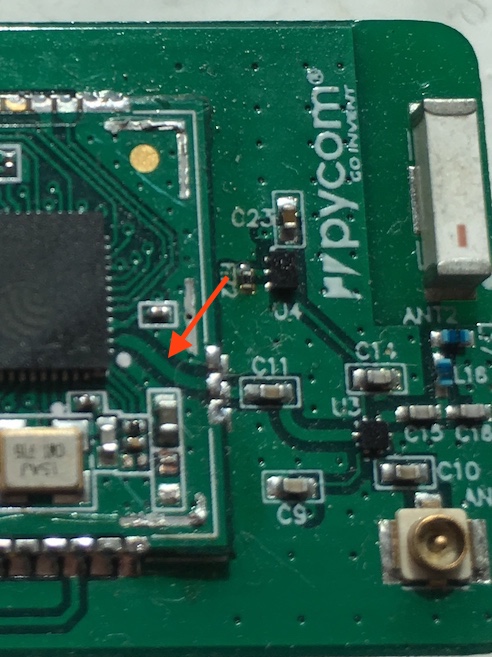Designing a board for the OEM modules
-
Hi,
i am designing a board with the WiPy OEM module.
There will be some questions during the process, i think.
My first question is about the antenna.
Do i need external capacitors or can i connect the antenna output directly to a 50 Ohm antenna?BTW, there is no tag for issues like this. I can only tag this post as Bug.
(i write this in order to include a bug post, so it matches ;-)Thank you in advance,
Richard
-
@danielm
Not that I know of. Personally - but I'm no RF expert - I'd just stick the known values into an online calculator such as https://www.eeweb.com/toolbox/pi-match
-
@jmarcelino
Is there any recommended design of pi matching network for external WiFi antenna connected through u.Fl connector?
-
BTW, is the WiPy OEM module bluetooth certified? :-)
The Bluetooth listing may be affordable, but whole certification is far more expensive...
-
that miniVNA looks really good... I should have paid more attention to that class. I remember messing with the smith chart..
-
@jmarcelino okay, thank you very much for your detailed answers, I appreciate this!
-
@Richard
Yes ESP32 documentation can be confusing - to everyone! :-)
My interpretation is: if you look at the version history of the datasheet you can see it has been updated with the new value (30+j10Ω) from the original 50Ω back in May so someone must have realised that it was incorrect.The impedance of the ESP8266 was also a weird 39+j6 Ω so non-standard RF impedances are nothing new to Espressif.
It's possible that that the phrase you quoted from the hardware design guide hasn't been changed to reflect this. The hardware design guide strongly suggests that you use a pi matching network anyway.
-
@jmarcelino said in Designing a board for the OEM modules:
You do need impedance matching because the ESP32's output impedance is 30 + j 10 Ω, not 50 Ω.
The datasheet Datasheet states that it is 30 + j 10 Ohm, but in the Hardware Design Guidelines i found this in section 3.2.1.4 RF
The characteristic RF impedance must be 50Ω
This is confusing ^^ What does that mean in practice?
Is it a contradiction that the output impedance is 30 + j10 Ohm, but a 50 Ohm antenna should be used?
-
@Richard said in Designing a board for the OEM modules:
Does that mean, that the antenna will adjust itself a bit to the board?
May well be true, but I think I see an antenna matching network inside Espressif's own module so I guess - even if true - it can only do so much.
-
@jmarcelino Thanks, the third option sounds reasonable, since it may become a commercial product, when it's ready :-)
I also found this statement in the ESP32 datasheet https://www.espressif.com/sites/default/files/documentation/esp32_datasheet_en.pdf in section 3.4.2:The use of digital calibration further improves the linearity of the power amplifier, enabling state-of-the-art performance of
delivering +20.5 dBm of average power for 802.11b transmission and +17 dBm for 802.11n transmission.
Additional calibrations are integrated to cancel any imperfections of the radio, such as:
• Carrier leakage
• I/Q phase matching
• Baseband nonlinearities
• RF nonlinearities
• Antenna matching
These built-in calibration routines reduce the amount of time required for product test and render test equipment
unnecessary.Does that mean, that the antenna will adjust itself a bit to the board?
-
@Richard
Is this going to be a commercial product? If so I recommend having it done professionally, otherwise any problem may become more much more expensive in certification.If it's more a hobby thing then you could try without a matching network (or add one but just bridged with 0 ohm resistors or /unpopulated) You'll probably suffer range/bandwidth issues, but you'll be in good company with thousands of other products :-)
The third option is to try and learnt if for yourself using something like the miniVNA. Warning this is a challenging - but rewarding - path.
-
@this.wiederkehr thanks, good point. Luckily i am not going to use the antenna switch.
-
@jmarcelino is there a way to make it work with an 50 Ohm external antenna without going into a lab for impedance matching? Is there a reference Layout for this? From the photo that you have postet, the dev-board seems not really optimized for the external antenna, or am i wrong?
Thank you for your replies so far!
-
@Richard said in Designing a board for the OEM modules:
are there maybe differences between the OEM module and this one on the dev-board?
As I see, another difference is, that on the dev-boards an internal pin (GPIO16) is used to control the antenna switch whereas on the baseboard design it's controlled by P12 GPIO21. So if you wan't to use the external switch you are loosing one IO with the oem module compared to the dev-board.
-
@jmarcelino hmm that is a bit unexpected
-
@jmarcelino are there maybe differences between the OEM module and this one on the dev-board? They are also different in RAM memory (from the specs).
-
@littlebat
Well that is interesting because the output of the module is just a simple micro strip from the ESP32 pin.
-
@littlebat are the 2 caps in the schematic for the antenna switch (the datasheet of the switch recommends capacitors, there) or actually for the connector?
-
@jmarcelino the chip output is 30+j10 but the module output should be 50. If you look at the baseboard schematic it just goes through 2 caps to the ipex connector.
-
@Richard
You do need impedance matching because the ESP32's output impedance is 30 + j 10 Ω, not 50 Ω.You also need to consider your specific conditions (board layout, enclosure) when saying the antenna is 50 Ω.